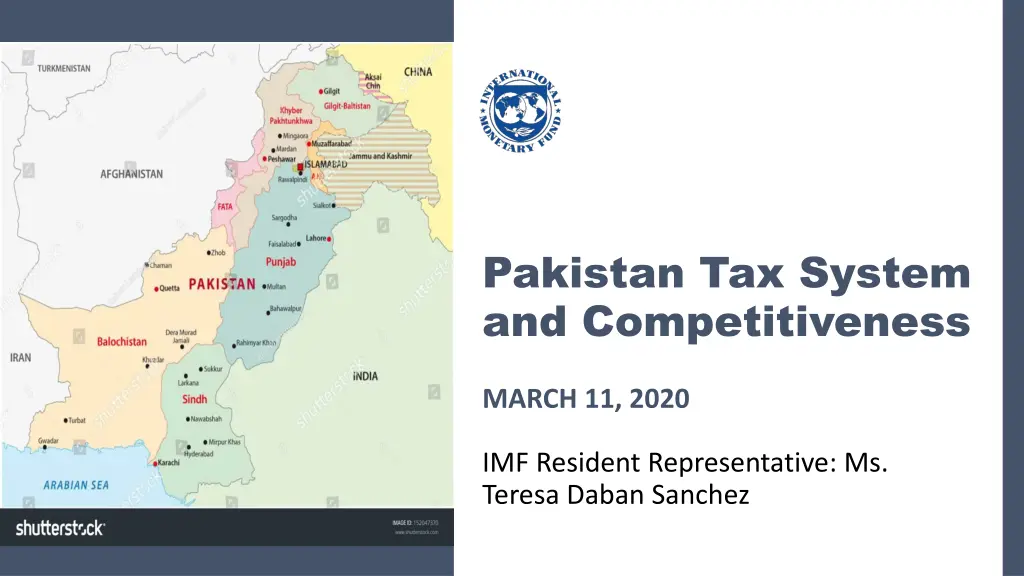
Pakistan Tax System Implications on Competitiveness
Explore the overview of Pakistan's tax system and its implications on competitiveness, including details on tax rates, low tax effort, complexity, and multiple objectives. Understand the challenges and opportunities within Pakistan's tax framework to enhance economic growth and fiscal stability.
Download Presentation

Please find below an Image/Link to download the presentation.
The content on the website is provided AS IS for your information and personal use only. It may not be sold, licensed, or shared on other websites without obtaining consent from the author. If you encounter any issues during the download, it is possible that the publisher has removed the file from their server.
You are allowed to download the files provided on this website for personal or commercial use, subject to the condition that they are used lawfully. All files are the property of their respective owners.
The content on the website is provided AS IS for your information and personal use only. It may not be sold, licensed, or shared on other websites without obtaining consent from the author.
E N D
Presentation Transcript
Pakistan Tax System and Competitiveness MARCH 11, 2020 IMF Resident Representative: Ms. Teresa Daban Sanchez
Outline of the Presentation Overview of Pakistan s tax system Implications, especially for competitiveness GST in Pakistan and its Harmonization Conclusions
Overview of Pakistans Tax System: Low Tax Effort Tax rates are on the high side (no room on CIT; VAT on destination with some room but informality is high) Selected Emerging and Developing Economies Neighbor Countries Pakistan OECD Tax Revenue (% of GDP) Income Taxes PIT CIT VAT Others of Good & Services On international trade On Property Other Taxes Social Security Contributions Taxes and Social Contributions 11.6 3.7 1.8 1.9 4.4 0.5 1.8 0.1 1.1 0.0 11.6 17.2 6.9 3.3 3.5 5.6 2.6 0.7 0.5 0.9 1.0 18.2 14.2 4.1 1.4 2.5 4.3 2.1 2.5 0.6 0.5 1.7 15.9 25.3 11.8 8.5 3.1 6.7 4.2 0.1 1.1 1.3 9.1 34.4 Tax-to-GDP ratio is very low, when compared to other Emerging markets and Neighboring Countries Impressive progress last year to eliminate exemptions, but still the tax system houses excessive benefits and privileges Tax Effort VAT Standard Rate Informal labor market (% of total) PIT minimum Rate PIT Top Marginal Rate CIT Standard Rate % CIT plus Dividends % 62.9 17.0 81.7 5.0 35.0 30.4 39.7 71.5 15.2 38.8 11.5 31.6 24.2 29.3 65.5 14.5 84.0 5.5 30.8 25.5 34.1 80.0 19.1 9.2 37.4 22.6 27.4 Pakistan s tax effort is very low, at 62 percent, compared with peers. Source: prepared by the mission with data from WEO; OECD; IBFD; ILO; and Tax Laws.
Overview of Pakistans Tax System: Complexity Extensive use of preferential and differential treatments Exemptions, reduced rates, zero rates (e.g. 14 rates for GST, numerous exemptions under CIT, two minimum income, one on grow income, another on accounting net income, etc.) A large volume of withholding taxes (and agents), for the GST and for the Income Tax Tax bases are fragmented, at times by the Constitution (e.g. GST on goods and GST on services), income tax on agriculture separate from general income tax, with little coordination
Overview of Pakistans Tax System: Multiple Objectives Tax system is understood as a mechanism to address multiple objectives, which weakens its revenue-raising function Objectives: Attracting investments, stimulating growth Reducing the price of food items Tackling compliance and enforcement problems Compensating for deficiencies in tax administration No country in the world uses their tax system to pursue so many objectives
Implications: Widespread Economic Distortions Tax system is highly distortionary and damaging to economic growth; ultimately, the pattern of consumption and production should not be dictated by the tax system (except in case of externalities). For example, the CIT base has been eroded by tax concessions that are unlikely to be effective in generating new investment or economic growth. This implies an administrative increase of tax rates and imposes an excessive burden on those who pay taxes, discouraging formalization.
Implications: Lack of Progressivity Property tax revenue is only 0.02 percent of GDP, which is low even by developing economies standards. At 1.9 percent of GDP, PIT revenues are also comparatively low. In OECD countries, the average is 8.5 percent of GDP, and in emerging and developing economies is 3.3 percent of GDP. This reflects a large informality, but also the PIT structure only a few individuals with incomes over 91 times GDP per-capita pay the top marginal rate of 35 percent while 72 percent of taxpayers pays only 5 percent tax or less, and a large number of exemptions.
Implications: Underutilization of Certain Taxes There is room to increase Petroleum Levy gradually, allowing consumers and producers time to adapt. Excises on tobacco could also be increased, including on unprocessed tobacco. The high incidence of illegal production and smuggling means enforcement must also improve, and implementation of track and trace system is key.
Implications: Excessive Reliance on Imports Import Tariff (Percent, simple average of most favored nation) Limited revenue mobilization and weak tax administration capacity has led to a reliance on import duties and related taxes. 20 16 More than 50 percent of federal tax revenue is collected at customs. In addition to the usual taxes (the ST, CD, and excises), advance tax regimes are imposed on IT and the ST, which operates as minimum taxes (see section below). This imposes an excessive final cost on importers . 12 8 4 Tariffs remain relatively high compared to peers. High effective protection has kept infant industries as children. Lower incentive to compete with imports or export 0 TZA MAR LBN THA LKA ARM VNM NPL COL UGA EGY PER GEO AFG BGD MYS IND CHN PAK PHL CHL TUR MUS IDN ZAF Sources: Fenochietto et al, Redesigning Pakistan's Tax System (2019)
GST in Pakistan: Two-Dimensional Problem 1. Tax base fragmented (inter-provincial issues) Taxation powers shared between federal government and provinces Complexity due to division of goods (federal) and services (provincial) 2. Tax rate - multiple standard and reduced rates Goods: 1%, 1.5%, 2%, 3%, 5%, 7%, 7.5%, 8%, 10%, 12%, 14%, 17%, 3 specific rates 4X Sales taxes on services: Standard rate: Balochistan, 15%; KP, 15%; Punjab, 16%; Sindh, 13% Other rates: 2%, 5%, 8%, 10%, 19.5%...
GST in Pakistan: W When the Tax Base is not Unified Incomplete Creditability Input crediting is more complicated (cross-checking and transfer of funds) Cascading tax on tax Exporting taxing Multiple tax laws and jurisdictions 5 revenue authorities Multiple reporting filing 5 tax returns Different taxes and base definitions across provinces Base disputes double taxation
GST in Pakistan: Erosion of Competitiveness Exporting taxes and uncompetitive export prices; with multiple GST rates it is harder to generate full information on the value chain, which is critical to remove all taxation from exports, and for not unnecessarily raising the costs of doing business. Encourages inefficient production choices; exports in Pakistan are unsophisticated and low valued added High compliance costs and difficulties to fight tax evasion; a proper GST is also critical in generating information to prevent the evasion of income taxes
GST Harmonization: Options for Harmonization First-best option constitutional change Second-best option agreements for collection and enforcement and harmonization: provinces maintain the tax powers to change some elements of the tax bases (e.g., rates between certain limits). Third option - harmonize the IT bases and those elements of the ST that may affect the allocation of the tax the ST rates of any activity taxed at origin basis should be equal in all provinces Where the ST applies on destination base, it is not necessary a full harmonization of the rate, but it is necessary to establish limits to avoid spillovers when cities of different jurisdictions are close
Conclusions Pakistan s tax system is characterized by a low level of collections, a large level of complexity, aimed at addressing too many objectives, fragmented, and with a large underutilization of certain taxes As a consequence, the system leads to widespread economic distortions, lack of inequality and an erosion of competitiveness. Pakistan needs urgently structural reforms to ensure robust revenue mobilization, while maximizing efficiency, equity, neutrality, and simplicity. One important reform to improve competitiveness is GST harmonization











